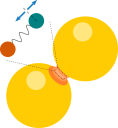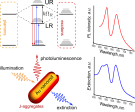The study of quantum optics has been my long-standing goal since I took a class at the university (very prematurely, all I remember from it is that the careful quantization of EM field is a difficult, time- and effort-consuming task).
However, with the help from Ruben Esteban and my supervisor – Javier Aizpurua from DIPC and CFM in San Sebastian, Alejandro Gonzalez-Tudela – a rather brilliant young physicist from Max Planck Institute for Quantum Optics (MPQ) in Germany and Geza Giedke from DIPC (previously at MPQ), I have managed to catch up with some of the elements I forgot from that class, and others that I must have missed.
Notably, a lot of my work is focused on introducing the formalism of quantum optomechanics into the field of plasmonics and vibrational spectroscopy. This concept is outlined in the following publication:

“Quantum mechanical description of Raman scattering from molecules in plasmonic cavities”, Mikołaj K. Schmidt, Ruben Esteban, Alejandro González-Tudela, Geza Giedke, and Javier Aizpurua, ACS Nano 10, 6291 (2016).
we study how the Raman scattering from molecules in plasmonic cavities can be described by the so-called optomechanical Hamiltonian; we are now collaborating with a few research group to try and verify our theoretical predictions
This paper contains also a short summary of results obtained through the standard methods used in the optomechanical community. For a great introduction to this approach, I wholeheartedly recommend two great reads from Carlos Navarrete-Benlloch:
- “Degenerate parametric oscillation in quantum membrane optomechanics,” Phys. Rev. A 93, 023846 (2016).
- “Degenerate optomechanical parametric oscillators: Cooling in the vicinity of a critical point,” Phys. Rev. A 93, 023819 (2016).
We have then applied this formalism to a paper which was prepared in collaboration with the research group of Jeremy Baumberg at Cambridge University published in Science:

“Single-molecule optomechanics in <<picocavities>>”, Felix Benz, Mikolaj K. Schmidt, Alexander Dreismann, Rohit Chikkaraddy, Yao Zhang, Angela Demetriadou, Cloudy Carnegie, Hamid Ohadi, Bart de Nijs, Ruben Esteban, Javier Aizpurua, Jeremy J. Baumberg, Science 354, 726-729 (2016).
individual atomic features inside the gap of a plasmonic nanoassembly can localize light to volumes well below 1 cubic nanometer, enabling optical experiments on the atomic scale; such extreme optical confinement yields a factor of 106 enhancement of optomechanical coupling between the picocavity field and vibrations of individual molecular bonds; this work sets the basis for developing nanoscale nonlinear quantum optics on the single-molecule level
For the work on other types of light-matter interactions in the quantum-mechanical framework, look here:
 “Rabi splitting in photoluminescence spectra of hybrid system of gold nanorods and J-aggregates”, Dzmitry Melnikau, Ruben Esteban, Diana Savateeva, Ana Sánchez-Iglesias, Marek Grzelczak, Mikołaj K. Schmidt, Luis M. Liz-Marzán, Javier Aizpurua, Yury P. Rakovich, Journal of Physical Chemistry Letters 7, 354-362 (2016).
“Rabi splitting in photoluminescence spectra of hybrid system of gold nanorods and J-aggregates”, Dzmitry Melnikau, Ruben Esteban, Diana Savateeva, Ana Sánchez-Iglesias, Marek Grzelczak, Mikołaj K. Schmidt, Luis M. Liz-Marzán, Javier Aizpurua, Yury P. Rakovich, Journal of Physical Chemistry Letters 7, 354-362 (2016).
here we demonstrate and describe the signatures of strong coupling between molecules and plasmonic particles in the fluorescence spectra
Furthermore, during my stay with Gabriel Molina-Terriza at Macquarie University, I have joined a project o characterize sources of entangled photons with various inseparability criteria.